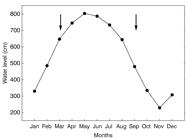The use of substitute groups in biomonitoring programs has been proposed to minimize the high financial costs and time for samples processing. The objectives of this study were to evaluate the correlation between (i) the spatial distribution among the major zooplankton groups (cladocerans, copepods, rotifers, and testaceans protozoa), (ii) the data of density and presence/absence of species, and (iii) the data of species, genera, and families from samples collected in the Lago Grande do Curuai, Pará, Brazil. A total of 55 sample of the zooplanktonic community was collected, with 28 samples obtained in March and 27 in September, 2013. The agreement between the different sets of data was assessed using Mantel and Procrustes tests. Our results indicated high correlations between genus level and species level and high correlations between presence/absence of species and abundance, regardless of the seasonal period. These results suggest that zooplankton community could be incorporated in a long-term monitoring program at relatively low financial and time costs.
Biomonitoring; Cladoceran; Copepod; Rotifer; Testate amoebae

 Thumbnail
Thumbnail
 Thumbnail
Thumbnail



